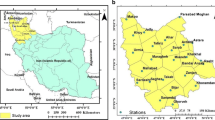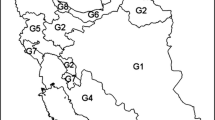Abstract
The monthly precipitation data from 29 synoptic stations for the period 1946–2012 were analyzed using a number of different multivariate statistical analysis methods to investigate the spatial variability and temporal patterns of precipitation across Serbia. R-mode principal component analysis was used to study the spatial variability of the precipitation. Three distinct sub-regions were identified by applying the agglomerative hierarchical cluster analysis to the two component scores: C1 includes the north and the northeast part of Serbia, while C2 includes the western part of Central Serbia and southwestern part of Serbia and C3 includes central, east, south and southeast part of Serbia. The analysis of the identified sub-regions indicated that the monthly and seasonal precipitation in sub-region C2 had the values above average, while C1 and C3 had the precipitation values under average. The analysis of the linear trend of the mean annual precipitation showed an increasing trend for the stations located in Serbia and three sub-regions. From the result of this analysis, one can plan land use, water resources and agricultural production in the region.













Similar content being viewed by others
References
Abdi H, Williams LJ (2010) Principal component analysis. WIREs Comp Stat 2:433–459
Alcamo J, Moreno JM, Nováky B, Bindi M, Corobov R, Devoy RJN, Giannakopoulos C, Martin E, Olesen JE, Shvidenko A (2007) Europe. In: Parry ML, Canziani OF, Palutikof JP, van der Linden PJ, Hanson CE (eds) Climate change 2007: Impacts, adaptation and vulnerability. Contribution of Working Group II to the Fourth assessment report of the Intergovernmental Panel on Climate Change. Cambridge University Press, Cambridge, UK, pp 541–580
Anderberg MR (1973) Cluster analysis for applications. Academic Press, New York
Apaydin H, Erpul G, Bayramin I, Gabriels D (2006) Evaluation of indices for characterizing the distribution and concentration of precipitation: a case for the region of Southeastern Anatolia Project, Turkey. J Hydrol 328:726–732
Baigorria GA, Jones JW, O'brien JJO (2007) Understanding spatial rainfall variability in southeast USA at different timescales. Int J Climatol 27:749–760
Bajat B, Pejovic M, Lukovic J, Manojlovic P, Ducic V, Mustafic S (2013) Mapping average annual precipitation in Serbia (1961–1990) by using regression kriging. Theor Appl Climatol 112:1–13
Bartlett MS (1954) A note on the multiplying factors for various χ 2 approximations. J R Stat Soc B 16:296–298
Bonaccorso B, Bordi I, Cancelliere A, Rossi G, Sutera A (2003) Spatial variability of drought: an analysis of the SPI in Sicily. Water Resour Manage 17:273–296
Bordi I, Fraedrich K, Jiang JM, Sutera A (2004) Spatio-temporal variability of dry and wet periods in eastern China. Theor Appl Climatol 79:81–91
Bunkers MJ, Miller JR, DeGaetano AT (1996) Definition of climate regions in the Northern plains using and objective cluster modification technique. J Clim 9:130–146
Cattell RB (1966) The Scree test for the number of factors. Multivar Behav Res 1:245–276
De Luis M, Gonzalez-Hidalgo CJ, Brunetti M, Longares LA (2011) Precipitation concentration changes in Spain 1946–2005. Nat Hazards Earth Syst Sci 11:1259–1265
Demsar U, Harris P, Brunsdon C, Fotheringham AS, McLoone S (2013) Principal component analysis on spatial data: an overview. Ann Assoc Am Geogr 103:106–128
Desa MN, Niemicynowicz MJ (1996) Temporal and spatial characteristics of rainfall in Kuala Lampur, Malaysia. Atmos Res 42:263–277
Dinpashoha Y, Fakheri-Farda A, Moghaddamb M, Jahanbakhshc S, Mirnia M (2004) Selection of variables for the purpose of regionalization of Iran's precipitation climate using multivariate methods. J Hydrol 297:109–123
Ekström M, Fowler HJ, Kilsby CG, Jones PD (2005) New estimates of future changes in extreme rainfall across the UK using regional climate model integrations: 1. Future estimates and use in impact studies. J Hydrol 300:234–251
Everitt BS (1993) Cluster analysis. Edward Arnold, London
Gocic M, Trajkovic S (2013a) Analysis of precipitation and drought data in Serbia over the period 1980–2010. J Hydrol 494:32–42
Gocic M, Trajkovic S (2013b) Analysis of changes in meteorological variables using Mann–Kendall and Sen's slope estimator statistical tests in Serbia. Global Planet Chang 100:172–182
Gonzalez-Hildago JC, De Luís M, Raventos S, Sanchez JR (2001) Spatial distribution of seasonal rainfall trends in a western Mediterranean area. Int J Climatol 21:843–860
Gordon AD (1999) Classification. Chapman & Hall/CRC, London
Gorsuch RL (1983) Factor analysis. Lawrence Erlbaum Associates, Philadelphia
Hotelling H (1933) Analysis of a complex of statistical variables into principal components. J Educ Psychol 24:417–441
Jolliffe IT (2002) Principal component analysis. Springer-Verlag, New York
Kaiser HF (1970) A second generation Little Jiffy. Psychometrika 35:401–415
Kalkestein LS, Tan G, Skindlov JA (1987) An evaluation of three clustering procedures for use in synoptic climatological classification. J Clim 26:717–730
Kaufman L, Rousseeuw PJ (1990) Finding groups in data: an introduction to cluster analysis. Wiley, New York
Kendall MG, Stuart A (1968) The advanced theory of statistics: design and analysis, and time-series. Charles Griffin & Company Limited, London
Kjellström E (2004) Recent and future signatures of climate change in Europe. Ambio 23:193–198
Martins DS, Raziei T, Paulo AA, Pereira LS (2012) Spatial and temporal variability of precipitation and drought in Portugal. Nat Hazards Earth Syst Sci 12:1493–1501
Ngongondo C, Xu CY, Gottschalk L, Alemaw B (2011) Evaluation of spatial and temporal characteristics of rainfall in Malawi: a case of data scarce region. Theor Appl Climatol 106:79–93
Norrant C, Douguédroit A (2006) Monthly and daily precipitation trends in the Mediterranean. Theor Appl Climatol 83:89–106
North GR, Bell TL, Cahalan RF, Moeng FJ (1982) Sampling errors in the estimation of empirical orthogonal functions. Mon Weather Rev 110:699–706
Oliver JE (1980) Monthly precipitation distribution: a comparative index. Prof Geogr 32:300–309
Pavlovic Berdon N (2012) The impact of Arctic and North Atlantic oscillation on temperature and precipitation anomalies in Serbia. Geogr Pannon 16:44–55
Pearson K (1901) On lines and planes of closest fit to systems of points in space. Phil Mag Ser 2:559–572
Philandras CM, Nastos PT, Kapsomenakis J, Douvis KC, Tselioudis G, Zerefos CS (2011) Long term precipitation trends and variability within the Mediterranean region. Nat Hazards Earth Syst Sci 11:3235–3250
Räisänen J, Hansson U, Ullerstig A, Döscher R, Graham LP, Jones C, Meier M, Samuelsson P, Willén U (2004) European climate in the late 21st century: regional simulations with two driving global models and two forcing scenarios. Clim Dynam 22:13–31
Raziei T, Bordi I, Pereira LS (2008) A precipitation-based regionalization for Western Iran and regional drought variability. Hydrol Earth Syst Sc 12:1309–1321
Rencher AC (2002) Methods of multivariate analysis. Wiley, New York
Richman MB (1986) Rotation of principal components. J Climatol 6:293–335
Rossel F, Garbrechtrt J (2001) Spatial variability and downscaling of precipitation. Phys Chem Earth Pt B 26:863–867
Shepard D (1968) A two-dimensional interpolation function for irregularly-spaced data. In: 23rd National conference ACM, ACM:517–524
Singh CV (2006) Pattern characteristics of Indian monsoon rainfall using principal component analysis (PCA). Atmos Res 79:317–326
Stricevic R, Djurovic N (2013) Determination of spatiotemporal distribution of agricultural drought in Central Serbia (Sumadija). Sci Res Essays 8:438–446
Tomozeiu R, Lazzeri M, Cacciamani C (2002) Precipitation fluctuations during the winter season from 1960 to 1995 over Emilia-Romagna, Italy. Theor Appl Climatol 72:221–229
Tosic I (2004) Spatial and temporal variability of winter and summer precipitation over Serbia and Montenegro. Theor Appl Climatol 77:47–56
Tosic I, Unkasevic M (2005) Analysis of precipitation series for Belgrade. Theor Appl Climatol 80:67–77
Tosic I, Unkasevic M (2013) Extreme daily precipitation in Belgrade and their links with the prevailing directions of the air trajectories. Theor Appl Climatol 111:97–107
Unkasevic M, Tosic I (2011) A statistical analysis of the daily precipitation over Serbia: trends and indices. Theor Appl Climatol 106:69–78
Unkasevic M, Tosic I, Vujovic D (2004) Variability and probability of annual and extreme precipitation over Serbia and Montenegro. Theor Appl Climatol 79:103–109
Ward JH (1963) Hierarchical grouping to optimize an objective function. J Am Stat Assoc 58:236–244
Acknowledgment
The study is supported by the Ministry of Education, Science and Technological Development, Republic of Serbia (Grant No. TR37003). We thank two anonymous referees for valuable comments and constructive suggestions that helped improve the final version of the article.
Author information
Authors and Affiliations
Corresponding author
Rights and permissions
About this article
Cite this article
Gocic, M., Trajkovic, S. Spatio-temporal patterns of precipitation in Serbia. Theor Appl Climatol 117, 419–431 (2014). https://doi.org/10.1007/s00704-013-1017-7
Received:
Accepted:
Published:
Issue Date:
DOI: https://doi.org/10.1007/s00704-013-1017-7




